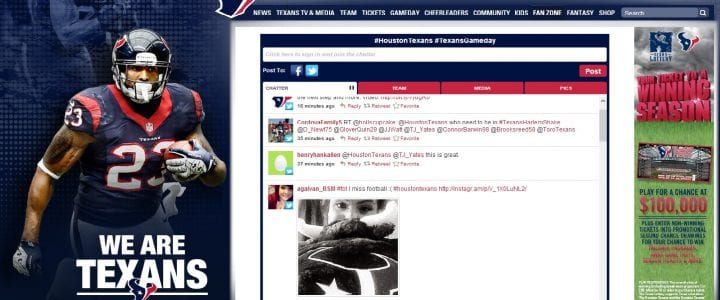by Jeannette Salas – April 2013
Social Media, Networking, Common 1st Year Mistakes, and Tips for Success
Social media shows up in the most unusual places
Employers frequently search candidates on Facebook, Twitter, Google+, Linked In, and blogs to see what they find. Maybe they find a cute picture of your dog (Griffie, above). Or maybe other things not so cute.
Some employers may say, “What you do outside of the organization is your own business.” But, at the end of the day, employers want great company representation 24/7/365.
The best way to find out what potential employers can see is to Google yourself. How can you manage your social media and use it to your advantage? Don’t publish anything in social media you wouldn’t want your mother (or next employer) to read or see.
While running a minor league sports team, a few arena employees were tweeting opinions on our low attendance one night. Once received on others’ feeds, tweets can’t be erased. Their comments were out there for the world to see, including their boss (me), our fans and customers and most importantly, any future employers of theirs. These young employees underestimated the power of social media, almost lost their jobs and could have damaged chances for employment elsewhere.
Social media is the new extension of your resume.
In what is an already difficult job market, employers use social media to eliminate candidates, even those with great resumes. As a hiring manager, once I found candidates I wanted to interview, I first looked them up in four places: Google, Facebook, Twitter and LinkedIn (images included). If anything at all gave me the sense they were unprofessional or wouldn’t represent our company well, they were eliminated immediately. While it’s cool to post fun pictures from your last vacation with your friends, think about who might see those pictures and how they may be construed.
Managing Social Media
- Make sure your profile picture is appropriate. Microsoft Outlook pulls up your social media profile picture whenever an email is received directly from you. Not sure a keg stand (or any other “party” picture) would get you in for an interview. THINK PROFESSIONAL!
- Beware of content in personal blogs! Everyone is subject to their own opinions BUT negative and/or inaccurate content can come back to haunt you. (See cancel culture circa 2021.)
- Social media outlets allow you to reach millions of people in seconds. Use it to your advantage when searching for jobs/internships. Let friends and family members know you are looking for a position.
Networking
When it comes to sports business careers, networking is king. Like everything else in life, it always comes down to relationships.
- Stay in touch. When you make a contact keep in touch. Forward your resume immediately after contact. Make contact at least every 6 months and after career achievements like graduation, obtaining a certificate [e.g., HR Cert, Sales Cert, etc], or an award.
- Join professional organizations and relevant social media networking sites and groups on LinkedIn like the S3 Report, Ticket Sales & Technology, or Ticket Sales Best Practices.
- Make sure your LinkedIn profile is complete and professional in appearance.
- These are great ways to connect with professionals that may be able to help you on your career path and offer insight, as well as search for positions.
- Some groups and individuals frequently post open positions. Follow them.
Common First Year Mistakes
Mistakes entry-level employees tend to make during the first year of employment:
- Lack of communication: Afraid to ask questions or for help; don’t call in when out sick; no notification of being late.
- Staying out of spotlight: Make an IMPACT within the organization; get involved in committees, events, etc.; EVERYONE should know who you are or at least heard of you.
- Poor networking: Get to know employees in other departments. This isn’t high school – don’t fall into a clique. Attend all company events – GREAT networking opportunity!
- Not leading: Don’t be scared to pitch ideas/take lead on projects. You bring a fresh thought process to the table – voice your ideas! Volunteer to take the lead on a project to develop leadership and project management skills.
- Complaining: DO NOT complain. PERIOD! Complaining is:
- unprofessional,
- unattractive, and
- unpromotable. People will not want to work with you or consider you for other positions within the organization. They will think of positions for you outside the organization.
- Inflexibility: Adapting to change is important. Business can change at the drop of a hat. Be open to new ways of completing tasks or approaching scenarios. Flexibility helps you grow with and within an organization and seamlessly transition into another one.
Tips for Success
- Continue learning. Stay abreast with the latest in your field. Attend training, seminars, conferences, and certificate programs.
- Ask for help. Not sure? Ask for clarification and guidance. Then you’ll be able to help others who don’t know.
- Ask for feedback. Feedback lets you know how you are doing and where you are lacking. This is essential for professional growth and development.
- Communicate. Make sure lines of communication are always clear and open.
- Create Raving Fans. A customer service based fundamental: All co-workers should enjoy working with you because your product is top quality and you are great to work with. If people like working with you they are more willing to help and listen to you.
- Read self-help books. Start with How to Win Friends and Influence Others and Emotional Intelligence. These are great books to help you continue growing both personally and professionally.
- Look to the future. Keep moving forward. Plan your career and move towards your ultimate goal.
Reinforcement from the Houston Astros![]()
I agree with all Jeannette points out. Two related thoughts to share:
Don’t underestimate the importance of a resume-appropriate email address. Stick with the traditional last name, first name (or some version of name). This format is simple and it works. An unprofessional address can mean the difference in a team contacting you regarding a job or passing you over for lack of professionalism.
In the interview, be sure to follow the lead of your interviewer. When you are informed at the beginning of the interview that this is going to be a quick phone screen (e.g., 10 minutes on Handshake), stick within that time frame. Everyone’s time is valuable. Sometimes you only have a short time span to sell yourself…PRACTICE THAT SKILL. It proves you can be clear, succinct and respectful of other people’s time. Consider it to be an extended elevator speech.
PS: That said, you need a 30-second elevator speech and a USP of eight words or less about who you are. Read m0re about branding you in our next article here.

~Jennifer Springs, HR, Houston Astros






 Senior Manager
Senior Manager


